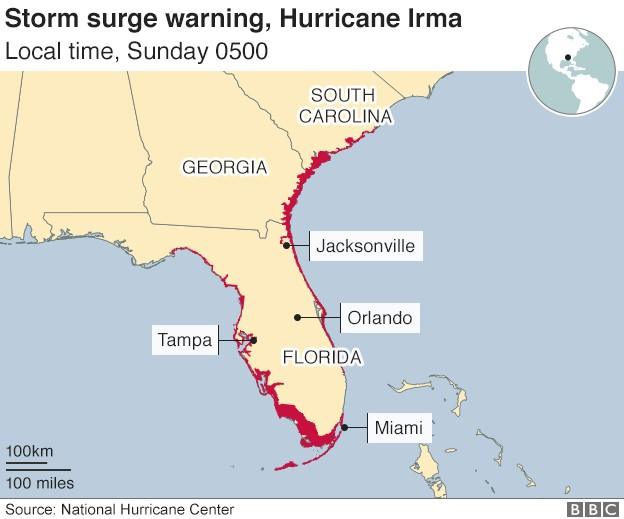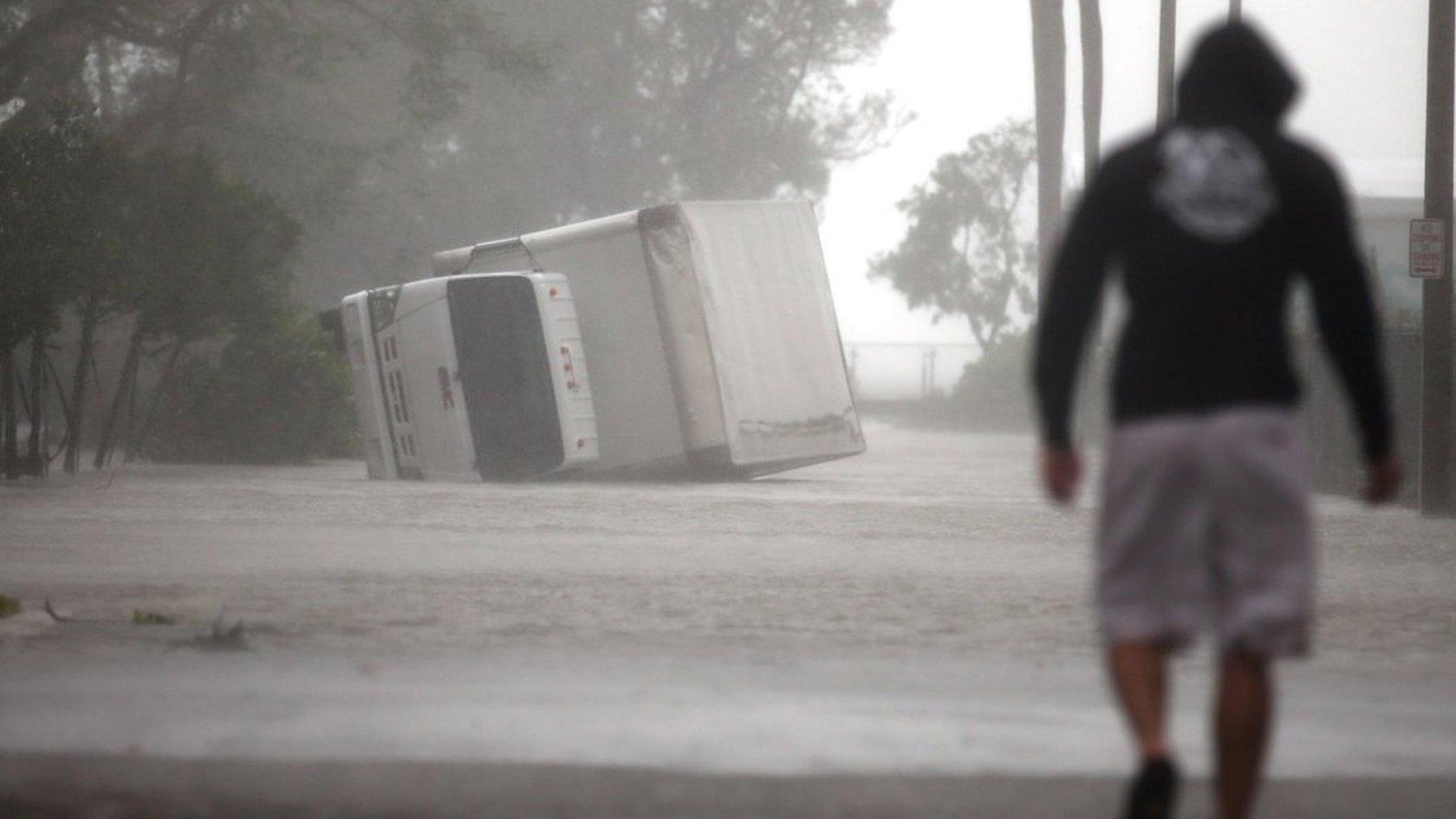Hurricane Irma: Massive storm bears down on Florida
- Published
WATCH: Amateur footage captures the storm pummelling the Keys
Parts of the city of Miami are under water as Hurricane Irma heads for mainland Florida, triggering storm surges across the south of the state.
Irma was downgraded to a category three storm at 1900 GMT, but made landfall on Marco Island off Florida's west coast with winds of up to 120mph (192km/h).
About 2ft (60cm) of water has been seen in Miami's financial district, where one major street resembled a river. Earlier Irma struck the Florida Keys.
More than 1m homes are without power.
Some 6.3 million people in Florida were told to evacuate, with warnings of a "life-threatening" storm surge.
Irma has already devastated parts of the Caribbean with at least 27 deaths.
BBC Weather's Ben Rich has the latest forecast
President Donald Trump described the hurricane as a "big monster". He praised the federal agencies involved with the storm and said he would go to Florida "very soon".
What is happening in Florida?
Extreme winds and storm surges continued in the Lower Florida Keys area, which includes Key West.
WATCH: Amateur footage shows a bay in Key Largo drained by Hurricane Irma
All residents had been ordered to leave.
One official had warned staying on the islands would be "almost like suicide".
Media reports say a man was killed on Saturday in the Keys when his truck crashed into a tree as the storm gathered pace.

As the eye of the storm is moving north to mainland Florida, more than 1.4 million homes in the state are reported to be without power and more than 100,000 people have taken refuge in shelters.
The National Hurricane Center tweeted , externalthat people in the area of Naples and Marco Island, in south-west Florida, should move away from the water as storm surges of up to 15ft (4.6m) were possible.
Cities such as Tampa and St Petersburg seem set to bear the brunt. The Tampa Bay area, with a population of about three million, has not been hit by a major hurricane since 1921.
"We are about to get punched in the face by this storm," Tampa Mayor Bob Buckhorn said.
Watch: Amateur footage shows flooding in central Miami
In Miami, Police Major Richard Rand told the BBC there was flooding, including 2-3ft inland, and many power lines were down.
One of the flooded areas was Miami's financial district, Brickell, where Southeast 12th Street resembled a river.
Two cranes have collapsed in high winds in the city.
The plane that flew into the eye of Hurricane Irma
Which other areas have already been hit?
Irma is the most powerful Atlantic storm in a decade, and has already caused widespread destruction on several Caribbean islands:
Cuba: Officials have talked of "significant damage", without giving further details, but no casualties have been reported. Electricity is out across the capital, Havana
St Martin and St Barthelemy: Six out of 10 homes on St Martin, an island shared between France and the Netherlands, are now uninhabitable, French officials say. They said nine people had died and seven were missing in the French territories, while four are known to have died in Dutch Sint Maarten
Turks and Caicos Islands: Widespread damage, although extent unclear
Barbuda: The small island is said to be "barely habitable", with 95% of the buildings damaged. Antigua and Barbuda Prime Minister Gaston Browne estimates reconstruction will cost $100m (£80m). One death has been confirmed
Anguilla: Extensive damage with one person confirmed dead
Puerto Rico: More than 6,000 residents of the US territory are in shelters and many more without power. At least three people have died
British Virgin Islands: Widespread damage reported, and five dead
US Virgin Islands: Damage to infrastructure was said to be widespread, with four deaths confirmed
Haiti and the Dominican Republic: Both battered by the storm, but neither had as much damage as initially feared

What about Hurricanes Jose and Katia?
Another storm, Jose, further out in the Atlantic behind Irma, is a category four hurricane, external, with winds of up to 130mph.
It initially followed a similar path to Irma and had threatened several islands already hit by its predecessor, but it has now tracked harmlessly to the north.
Barbuda, whose residents had already left the island as Jose approached, was spared, as were St Martin and St Barthelemy.
Hurricane Katia, in the Gulf of Mexico, a category one storm with winds of up to 75mph, made landfall on the Mexican Gulf coast in the state of Veracruz late on Friday before weakening to a tropical depression.
BBC Weather's Ben Rich has the latest forecast

Are you in the region? Are you a holidaymaker unable to get a flight home or a resident who has been preparing for Hurricane Irma? If it is safe for you to do so, share your experiences by emailing haveyoursay@bbc.co.uk, external.
Please include a contact number if you are willing to speak to a BBC journalist. You can also contact us in the following ways:
WhatsApp: +447555 173285
Tweet: @BBC_HaveYourSay, external
Send pictures/video to yourpics@bbc.co.uk, external
Upload your pictures / video here, external
Send an SMS or MMS to 61124 or +44 7624 800 100
Please read our terms & conditions
- Published6 September 2017
